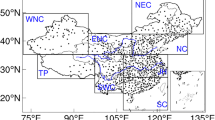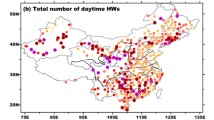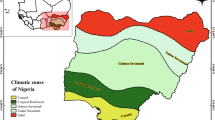Abstract
Based on combined thresholds of daily maximum and minimum temperatures, a compound heat wave is defined, and then changes in multiple aspects of such heat waves in China are estimated between 1961 and 2015. Our results intriguingly indicate that severe compound heat waves in northern China are characterized by excessively high intensity within short duration, while long duration determines great disaster-causing potential of severe events in the south. In the past few decades, large areas of China have experienced longer, stronger, and more frequent compound heat waves. Northern China has witnessed dramatic intensity increases, with a maximum amplification over 5°C decade–1; while remarkable lengthening in duration has been mostly recorded in the south, with a maximum trend over 1 day decade–1. The spatial extent affected by compound heat waves has significantly expanded since the 1960s, with the largest expanding rate over 6% decade–1 detected in North China and Northeast China. These systematic assessments serve to deepen our understanding of observed changes in compound heat waves across China, and may further shed some light on future adaptations and mitigations against an increasingly warming climate.
Similar content being viewed by others
References
Anderson, G. B., and M. L. Bell, 2011: Heat waves in the United States: Mortality risk during heat waves and effect modification by heat wave characteristics in 43 U.S. communities. Environmental Health Perspectives, 119, 210–218, doi: 10.1289/ehp.1002313.
Basu, R., and J. M. Samet, 2002: Relation between elevated ambient temperature and mortality: A review of the epidemiologic evidence. Epidemiologic Reviews, 24, 190–202, doi: 10.1093/epirev/mxf007.
Bian, T., G. Y. Ren, B. X. Zhang, et al., 2015: Urbanization effect on long-term trends of extreme temperature indices at Shijiazhuang station, North China. Theor. Appl. Climatol., 119, 407–418, doi: 10.1007/s00704-014-1127-x.
Chen, K., J., Bi, J. Chen, et al., 2015: Influence of heat wave definitions to the added effect of heat waves on daily mortality in Nanjing, China. Science of the Total Environment, 506–507, 18–25, doi: 10.1016/j.scitotenv.2014.10.092.
Chen, M., F. H. Geng, L. M. Ma, et al., 2013: Analyses on the heat wave events in Shanghai in recent 138 years. Plateau Meteor., 32, 597–607. (in Chinese)
Chen, Y., and P. M. Zhai, 2013: Persistent extreme precipitation events in China during 1951–2010. Climate Research, 57, 143–155, doi: 10.3354/cr01171.
Della-Marta, P. M., M. R. Haylock, J. Luterbacher, et al., 2007: Doubled length of western European summer heat waves since 1880. J. Geophys. Res., 112, D15103, doi: 10.1029/2007JD008510.
Ding, T., and W. H. Qian, 2011: Geographical patterns and temporal variations of regional dry and wet heatwave events in China during 1960–2008. Adv. Atmos. Sci., 28, 322–337, doi: 10.1007/s00376-010-9236-7.
Ding, T., W. H. Qian, and Z. W. Yan, 2010: Changes in hot days and heat waves in China during 1961–2007. Int. J. Climatol., 30, 1452–1462, doi: 10.1002/joc.1989.
D’Ippoliti, D., P. Michelozzi, C. Marino, et al., 2010: The impact of heat waves on mortality in 9 European cities: Results from the EuroHEAT project. Environmental Health, 9, 37, doi: 10.1186/1476-069X-9-37.
Du, H. Y., D. D. Wang, Y. Y. Wang, et al., 2016: Influences of land cover types, meteorological conditions, anthropogenic heat and urban area on surface urban heat island in the Yangtze River Delta Urban Agglomeration. Science of the Total Environment, 571, 461–470, doi: 10.1016/j.scitotenv.2016.07.012.
Fischer, E. M., and C. Schär, 2010: Consistent geographical patterns of changes in high-impact European heatwaves. Nature Geoscience, 3, 398–403, doi: 10.1038/ngeo866.
Gao, J. H., Y. Z. Sun, Q. Y. Liu, et al., 2015: Impact of extreme high temperature on mortality and regional level definition of heat wave: A multi-city study in China. Science of the Total Environment, 505, 535–544, doi: 10.1016/j.scitotenv.2014.10.028.
García-Herrera, R., J. Díaz, R. M. Trigo, et al., 2010: A review of the European summer heat wave of 2003. Critical Reviews in Environmental Science and Technology, 40, 267–306, doi: 10.1080/10643380802238137.
Grize, L., A. Huss, O. Thommen, et al., 2005: Heat wave 2003 and mortality in Switzerland. Swiss Medical Weekly, 135, 200–205.
Guo, X. J., J. B. Huang, Y. Luo, et al., 2017: Projection of heat waves over China for eight different global warming targets using 12 CMIP5 models. Theor. Appl. Climatol., 128, 507–522, doi: 10.1007/s00704-015-1718-1.
Hajat, S., B. Armstrong, M. Baccini, et al., 2006: Impact of high temperatures on mortality: Is there an added heat wave effect? Epidemiology, 17, 632–638, doi: 10.1097/01.ede.0000239688.70829.63.
Jiang, Z. H., J. Song, L. Li, et al., 2012: Extreme climate events in China: IPCC-AR4 model evaluation and projection. Climatic Change, 110, 385–401, doi: 10.1007/s10584-011-0090-0.
Jones, P. D., S. C. B. Raper, R. S. Bradley, et al., 1986: Northern Hemisphere surface air temperature variations: 1851–1984. J. Climate Appl. Meteor., 25, 161–179, doi: 10.1175/1520-0450(1986)025<0161:NHSATV>2.0.CO;2.
Kalkstein, L. S., and K. E. Smoyer, 1993: The impact of climate change on human health: Some international implications. Experientia, 49, 969–979, doi: 10.1007/BF02125644.
Kalkstein, L. S., J. S. Greene, D. M. Mills, et al., 2008: Analog European heat waves for U.S. cities to analyze impacts on heat-related mortality. Bull. Amer. Meteor. Soc., 89, 75–85, doi: 10.1175/BAMS-89-1-75.
Karl, T. R., and R. W. Knight, 1997: The 1995 Chicago heat wave: How likely is a recurrence? Bull. Amer. Meteor. Soc., 78, 1107–1119, doi: 10.1175/1520-0477(1997)078<1107:TCHWHL>2.0.CO;2.
Kuglitsch, F. G., A. Toreti, E. Xoplaki, et al., 2010: Heat wave changes in the eastern Mediterranean since 1960. Geophys. Res. Lett., 37, L04802, doi: 10.1029/2009GL041841.
Lemonsu, A., V. Viguié, M. Daniel, et al., 2015: Vulnerability to heat waves: Impact of urban expansion scenarios on urban heat island and heat stress in Paris (France). Urban Climate, 14, 586–605, doi: 10.1016/j.uclim.2015.10.007.
Li, X. P., L. Wang, D. L. Chen, et al., 2013: Near-surface air temperature lapse rates in the mainland China during 1962–2011. J. Geophys. Res., 118, 7505–7515, doi: 10.1002/jgrd.50553.
Liu, J., and P. M. Zhai, 2014: Changes in climate regionalization indices in China during 1961–2010. Adv. Atmos. Sci., 31, 374–384, doi: 10.1007/s00376-013-3017-z.
Meehl, G. A., and C. Tebaldi, 2004: More intense, more frequent, and longer lasting heat waves in the 21st century. Science, 305, 994–997, doi: 10.1126/science.1098704.
Patz, J. A., D. Campbell-Lendrum, T. Holloway, et al., 2005: Impact of regional climate change on human health. Nature, 438, 310–317, doi: 10.1038/nature04188.
Perkins, S. E., L. V. Alexander, and J. R. Nairn, 2012: Increasing frequency, intensity and duration of observed global heatwaves and warm spells. Geophys. Res. Lett., 39, L20714, doi: 10.1029/2012GL053361.
Ren, G. Y., and Y. Q. Zhou, 2014: Urbanization effect on trends of extreme temperature indices of national stations over mainland China, 1961–2008. J. Climate, 27, 2340–2360, doi: 10.1175/JCLI-D-13-00393.1.
Robinson, P. J., 2001: On the definition of a heat wave. J. Appl. Meteor., 40, 762–775, doi: 10.1175/1520-0450(2001)040<0762:OTDOAH>2.0.CO;2.
Schär, C., P. L. Vidale, D. Lüthi, et al., 2004: The role of increasing temperature variability in European summer heat waves. Nature, 427, 332–336, doi: 10.1038/nature02300.
Sen, P. K., 1968: Estimates of the regression coefficient based on Kendall’s tau. Journal of the American Statistical Association, 63, 1379–1389, doi: 10.1080/01621459.1968.10480934.
Serreze, M. C., J. E. Walsh, F. S. Chapin III, et al., 2000: Observational evidence of recent change in the northern high-latitude environment. Climatic Change, 46, 159–207, doi: 10.1023/A:1005504031923.
Simolo, C., M. Brunetti, M. Maugeri, et al., 2011: Evolution of extreme temperatures in a warming climate. Geophys. Res. Lett., 38, L16701, doi: 10.1029/2011GL048437.
Smith, T. T., B. F. Zaitchik, and J. M. Gohlke, 2013: Heat waves in the United States: Definitions, patterns and trends. Climatic Change, 118, 811–825, doi: 10.1007/s10584-012-0659-2.
Stocker, T. F., D. Qin, G. K. Plattner, et al., 2013: Climate Change 2013: The Physical Science Basis. Contribution of Working Group I to the Fifth Assessment Report of the Intergovernmental Panel on Climate Change. Cambridge University Press, 1308 pp.
Sun, Y., X. B. Zhang, F. W. Zwiers, et al., 2014: Rapid increase in the risk of extreme summer heat in Eastern China. Nature Climate Change, 4, 1082–1085, doi: 10.1038/nclimate2410.
Vanos, J. K., L. S. Kalkstein, and T. J. Sanford, 2015: Detecting synoptic warming trends across the US Midwest and implications to human health and heat-related mortality. Int. J. Climatol., 35, 85–96, doi: 10.1002/joc.3964.
Wang, L. Y., X. Yuan, Z. H. Xie, et al., 2016: Increasing flash droughts over China during the recent global warming hiatus. Scientific Reports, 6, 30571, doi: 10.1038/srep30571.
Wang, Z. Y., Y. H. Ding, Q. Zhang, Y. F. Song, et al., 2012: Changing trends of daily temperature extremes with different intensities in China. Acta Meteor. Sinica, 26, 399–409, doi: 10.1007/s13351-012-0401-z.
Wei, K., and W. Chen, 2011: An abrupt increase in the summer high temperature extreme days across China in the mid- 1990s. Adv. Atmos. Sci., 28, 1023–1029, doi: 10.1007/s00376-010-0080-6.
Xia, J. J., K. Tu, Z. W. Yan, et al., 2016: The super-heat wave in eastern China during July–August 2013: A perspective of climate change. Int. J. Climatol., 36, 1291–1298, doi: 10.1002/joc.2016.36.issue-3.
Xue, Y. K., 1996: The impact of desertification in the Mongolian and the Inner Mongolian grassland on the regional climate. J. Climate, 9, 2173–2189, doi: 10.1175/1520-0442(1996)009<2173:TIODIT>2.0.CO;2.
Ye, D. X., J. Yin, Z. H. Chen, et al., 2013: Spatiotemporal change characteristics of summer heatwaves in China in 1961–2010. Progressus Inquisitiones de Mutatione Climatis, 9, 15–20, doi: 10.3969/j.issn.1673-1719.2013.01.003. (in Chinese)
Zhang, X. B., L. Alexander, G. C. Hegerl, et al., 2011: Indices for monitoring changes in extremes based on daily temperature and precipitation data. Wiley Interdisciplinary Reviews: Climate Change, 2, 851–870, doi: 10.1002/wcc.147.
Zou, X. K., P. M. Zhai, and Q. Zhang, 2005: Variations in droughts over China: 1951–2003. Geophys. Res. Lett., 32, doi: 10.1029/2004GL021853.
Author information
Authors and Affiliations
Corresponding author
Additional information
Supported by the National Basic Research and Development (973) Program of China (2013CB430203 and 2012CB417205), China Meteorological Administration Special Public Welfare Research Fund (GYHY201306033), National Natural Science Foundation of China (41275073), Program of Science and Technology Development in Sichuan Meteorological Bureau (2014-09), and Project for Postgraduate Scientific Research and Innovation of Jiangsu Province (KYLX16_0933).
Rights and permissions
About this article
Cite this article
Li, Y., Ding, Y. & Li, W. Observed trends in various aspects of compound heat waves across China from 1961 to 2015. J Meteorol Res 31, 455–467 (2017). https://doi.org/10.1007/s13351-017-6150-2
Received:
Accepted:
Published:
Issue Date:
DOI: https://doi.org/10.1007/s13351-017-6150-2




